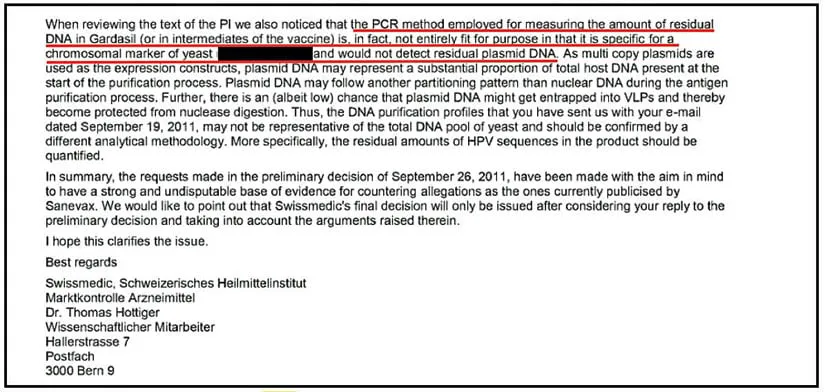A landmark lawsuit against Merck is underway in a Los Angeles courtroom, marking the company’s first jury trial over claims it misrepresented the safety of its highly profitable Gardasil HPV vaccine.
Newly declassified documents in the trial have revealed troubling details about Merck’s failure to conduct key safety tests.
 |
| Image Credit: Manjurul / Getty |
Internal emails reveal that Merck knew its Gardasil vaccine was contaminated with HPV DNA fragments from the vaccine‘s manufacturing process and lobbied regulators to bypass testing requirements.
Uncovering residual DNA contamination
Concerns over Gardasil’s residual DNA contamination have persisted for over a decade.
In 2011, Dr. Sin Hang Lee, a pathologist with extensive experience in DNA analysis, discovered high levels of HPV DNA fragments in 16 Gardasil vials from several countries, including the U.S., New Zealand, Australia, Spain, Poland and France. (See previous story here.)
These DNA fragments, originating from the plasmid DNA used in vaccine production to code for the HPV virus’s L1 protein, are supposed to be removed during manufacturing.
Instead, high levels of HPV DNA fragments remain in the final product and tightly bind to the aluminum adjuvant. Unlike free DNA molecules in solution, the aluminum-bound HPV DNA is stabilized and resists breakdown by enzymes.
Once injected, these aggregates are absorbed by immune cells and activate Toll-like receptor 9(TLR9), triggering pro-inflammatory responses.
According to Lee, for some individuals, particularly those with genetic predispositions, this can lead to autoimmune conditions such as postural orthostatic tachycardia syndrome (POTS) or, in rare cases, sudden death.
Notably, Gardasil’s package inserts make no mention of the presence of HPV DNA or its potential to trigger immune responses.
Internal emails reveal negligence and cover-up
Lee is set to testify in the lawsuit, and his witness statement provides key evidence suggesting Merck was aware of the issue of HPV DNA contamination but failed to act.
Following Lee’s findings in 2011, Merck was asked by the Swiss drug regulator, Swissmedic, to provide data on HPV DNA levels in Gardasil.
In response, Merck’s Chief Medical Officer Carlos Sattler made a revealing admission to his colleagues in an internal email. On Sept. 8, 2011, Sattler admitted “We did not specifically look for the HPV L1 plasmid DNA.”
Despite this, Sattler downplayed the significance of the contamination, stating that Merck had “no plans” to conduct any testing and that, even if small amounts were present, there was “no evidence that this would be associated with any risk.
The next day, Merck scientist Annie Sturgess confirmed, “We have not directly measured HPV DNA” in the vaccine.
Merck attempted to satisfy Swissmedic by estimating the level of HPV DNA using “yeast DNA” content as a proxy, but the regulator rejected this approach.
Thomas Hottiger, Ph.D., of Swissmedic warned Merck that its method was “not entirely fit for purpose” and explained that the company would need to use a PCR test specific for detecting HPV plasmid DNA, which behaves differently from yeast DNA.
Merck’s North American representative, Dave Wohlpart, expressed reluctance to perform such testing and proposed to his colleagues that Merck “not do testing” altogether.
On Oct. 21, 2011, the U.S. Food and Drug Administration (FDA) made a public announcement claiming that Merck had actually known that “small quantities of residual recombinant HPV L1-specific DNA fragments remain in the vaccine.”
This disclosure came as a surprise to Merck.
Frank Vandendriessche, Merck’s director of Regulatory Affairs in Europe, reacted to the FDA’s announcement, writing in an email that the company had “never tested specifically for HPV L1 DNA fragments.”
Merck used the situation to its advantage to suggest it was now a moot point. Armed with the FDA’s announcement, Merck lobbied Swissmedic to withdraw its request for new data.
Swissmedic obliged, granting a waiver for specific HPV DNA testing. Instead, Merck was instructed to make a minor change to the product’s label — effectively burying the issue.
Regulatory failure: Complicity or incompetence?
Gardasil was approved and distributed globally without proper testing for HPV L1 DNA contamination. Instead of enforcing rigorous safety standards, regulators allowed Merck’s flawed testing procedures to pass unchecked.
Even when evidence of contamination surfaced, regulators largely overlooked it, revealing a pattern of negligence and wilful blindness.
Their reluctance to demand accountability suggests either regulatory capture or gross incompetence — both of which have devastating consequences for the millions who have received the vaccine.
This trial may not only determine Merck’s liability — it could force a long-overdue reckoning with the regulatory agencies that have shielded pharmaceutical giants from scrutiny for far too long.
Lee will take the stand and testify at the trial on Feb. 13.
Originally published on Maryanne Demasi’s Substack page.
По материалам: http://www.planet-today.com/2025/02/merck-fda-knew-gardasil-hpv-vaccine-was.html




